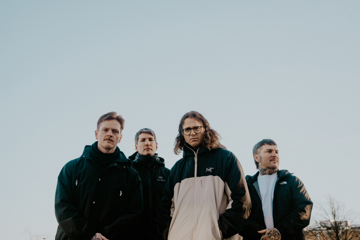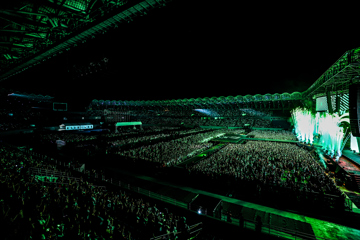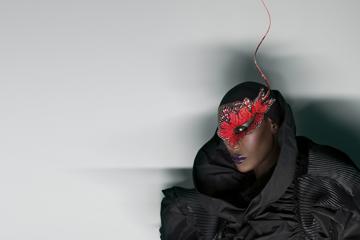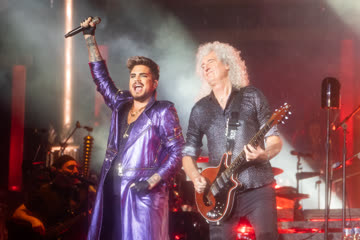Dark Mofo Artist Paul Yore: Do We Really Care About The Kardashians As People?
Artist Paul Yore talks to Hannah Story about worshipping at the altar of Justin Bieber.
Paul Yore’s It’s All Wrong But It’s Alright – exhibiting as part of Dark Mofo – fills a deconsecrated Congregational church in Hobart with thousands of brightly coloured objects, collected over ten years, from pop culture paraphernalia to dildos.
The installation, which also features water fountains, video, music and flashing lights – a deliberate sensory overload – is described as a “technicolour chapel”, devoted to “icons of love, sex and excess” like Dolly Parton and Justin Bieber.
Yore says his artistic practice is fundamentally “centred on queer subjectivity”: “I'm very interested in how identity and subjectivity is formed particularly in the context of late capitalism and mass globalised society, where there's increasing discordance between our culture and our identity, and the shift between how these things are formed within society.”
"“I'm very interested in how identity and subjectivity is formed particularly in the context of late capitalism and mass globalised society."
Talking to The Music from his home in Victoria’s Gippsland region, the artist explains how exciting it is for his work to exist outside of the “institutional art context” of the gallery, and see it instead butt up against a different set of traditions and values.
“My work's to be exhibited in a deconsecrated church – a 19th century church – which is a really challenging architectural space,” Yore begins. “But [it’s] also a really exciting space in terms of forming a context for some of my ideas around identity, politics and globalised pop culture, within what would traditionally be seen as quite a conservative or traditional context.”
Don't miss a beat with our FREE daily newsletter
While there’s tension between his work and the space – in the incorporation of sex and explicit 21st century queer symbology – there’s parallels too. Yore says his practice is informed by the history of Western art, which has, historically, been tied to the Catholic Church. To take that influence, and to build a shrine to the icons of our popular, post-capitalist culture in a former place of worship, then seems like a subversive – albeit humorous – act.
“My work's informed partly by the art period of the Baroque,” Yore explains. ”[The Baroque period] was the 17th century Catholic art movement that sought to reinstate the Church's position using a lot of decoration, a lot of exuberance in wealth and it's quite an ecstatic art movement.
“Some of the images are almost homoerotic if you look at that period, you look at images of Christ or Saint Sebastian in these quite ecstatic poses – there is a lot of flamboyance. So while there is a lot of tension between my work, because it is queer art, set in a church, there is also a resonance with that space as well.”
Still, there’s something to be unpicked in It’s All Wrong But It’s Alright about our culture’s turn away from organised religion – 30.1% of Australians identified as non-religious in the 2016 census – and potential move towards worshipping, or perhaps the right word is stanning, Ariana Grande, Justin Bieber, et al.
“It's interesting to see now a move towards the inward-looking materialism and consumerism of internet culture and capitalism generally wherein figures – like pop cultural icons, Justin Bieber and whatnot – do perhaps form, in an almost fetishistic way, the fringes of a kind of cult or idol worship. My work seeks to criticise and critique that as well as celebrate that.”
The critique of celebrity or consumer culture in It’s All Wrong But It’s Alright centres on the ideas of shallowness and instant gratification. Yore talks about the way we use the internet, moving through digital spaces rapidly, almost vacuously, and what that says about our connections to these ‘revered’ people.
“I'm interested in whether there's a hollowness behind that type of culture. We see with the cult of celebrity – whether it's the Kardashians or pop icon figures, Britney Spears, whoever it is – that it centres around a superficial image that's constructed, but are we really interested in the person behind that or the ideas behind that? Or is it just a sort of smokescreen or a mirage almost?”
In the process of creating the work, Yore ransacked – he describes it as “cannibalised” – his previous work, reconstructing and reimagining his installations from as far back as 2008. In the process, he’s pooled together “junk” from op shops or magazines with images of sex and sexuality – a practice validated by the constant collage of internet culture (see: Tumblr).
“I don't really separate the sacred and the profane in my work.”
“I don't really separate the sacred and the profane in my work,” Yore says. “I like the idea of collapsing these hierarchies, that maybe in our internet culture there's less of a separation now between what constitutes art, good taste, high culture, and what constitutes low culture, consumer culture.”
Yore’s work seems to challenge definitions of what ‘art’ is and can be, and who it’s for. He sees the use of bright colour, humour and cultural references as part of the politics of his work, opening up the art world to everybody, and blurring the line between highbrow and low culture.
“Even though I explore a lot of bigger issues and challenging subject matter in my work, I'm always trying to couch my ideas within quite an accessible, visually exciting and sensorial way. That's to make the work as accessible as possible, so that young people or people who don't have a background in art can actually come to it and still get something out of it.”
In June 2013, police raided Yore’s installation Everything Is Fucked in Melbourne after complaints about ‘child pornography’ – collages where children’s faces where superimposed on male bodies performing sex acts. The charges against the artist were dismissed in October 2014. How does that experience inform his perspective on both his practice and what art in Australia can be?
Yore cites a “long history of censorship in the arts in Australia”, which he sees as a “challenge”: “Art is supposed to be challenging in my opinion. It shouldn’t necessarily reinforce people’s view of the world or make us feel comfortable.
“I think that art has a social role – its role is to actually challenge our basic assumptions about what art can be, what society can be, and explore ideas that maybe make us think about things in a different way. And because art is a mediated space I see it as a safe space where fundamentally what we're exploring is ideas.
“The world out there, let's face it, is quite a scary place – art is actually a really safe, mediated space where we can actually talk about things in a very open and candid way. And whether that's ideas around taboo or sexuality or politics, I think that's really important.”
Paul Yore: It’s All Wrong But It’s Alright runs from 7 Jun at Black Temple Gallery.







